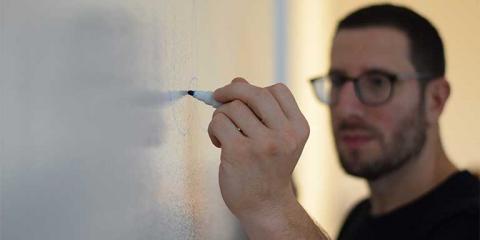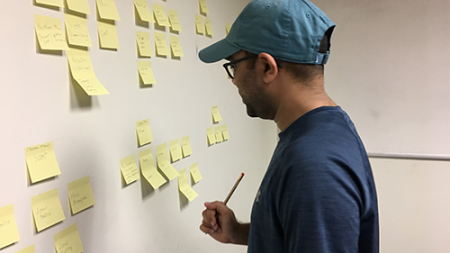
Related Class
How to improve creativity by 50%
- Published on

The process to improve creativity is something that can be applied across every profession and role. Improving creativity provides important benefits for people at all ages and levels or work. Creative thinking is often associated with designers, artists, architects, and other creative professionals, but it extends to most every job function. Creative thinking skills are used by virtually all people, young and old, students and professionals, and extend far beyond artists, designers and creative professionals.
Benefits of improving creative thinking skills
Improving creative thinking skills helps problem solving, improves attention, and reduces mental fatigue. A cognitive psychologist at the University of Utah even demonstrated a 50% improvement in creative problem solving skills on an exam when he tested a group of study participants after working to improve their creative thinking skills.
Process for improving creativity
The method for improving creativity does not require a multi-step process or elaborate planning. All that is required to improve creative thinking is to spend time outside in a natural setting. Yes, spending time in nature improves creative thinking. It’s not an old idea, Cyrus the Great built relaxation gardens in ancient Persia thousands of years ago. Anecdotal evidence shows that many creative thinkers value spending time outside. Steve Jobs was known for taking walks through parks and trails while meeting with colleagues. Jennifer Smith who runs the user experience workshops at American Graphics Institute says "Getting outside and taking a walk can help to clear my head, letting me return to my desk with a renewed focus and improved creativity."
Why creativity regeneration is necessary
Brains are not machines that can work tirelessly, and creative thinking doesn’t occur on-demand. The brain needs a chance to rest, rebuild, and reset in order to be at peak creative levels. Many psychologists view the distractions that are associated with modern life, from cell phones to constant connectivity, as contributing to mental fatigue. David Strayer is the environmental psychologist from Utah who conducted the study that showed it is possible to improve creativity. He describes a three day effect that occurs after spending 72 hours in nature. The prefrontal cortex of the brain is able to rest, and it shows reduced output on an EEG device which measures midline frontal theta waves.
More studies show creative thinking improvements
Spending time outside seems to be a simple solution for improving creative thinking and overall mental health. Taking a walk in a natural environment such as an arboretum for 50 minutes has been shown to improve short term memory and other executive functions according to a study by environmental psychologists Stephen Kaplan at University of Michigan. A control group that took walks of a similar duration within a city did not see the same improvements to creative thinking or executive functioning.
Additional benefits to improving creative thinking
The benefits go beyond creative thinking improvements when spending time in nature. An epidemiologist at the University of Scotland performed a large scale study and found people living in near parks and green-spaces had lower death and disease rates. The author of the study indicates that the data shows being near natural environments likely reduces stress hormones, creating a calming effect, and improving mental performance. These benefits are being realized around the globe. The Chungbuk University in South Korea now offers a Forest Healing Degree, using nature as a way to help with healing physical and mental health.
Next generation at risk
The benefits of improved creativity and health benefits associated with spending time in nature appear to be unlikely to carry into the next generation in the United States. A Harvard School of Public Health survey found that only approximately 10 percent of teenagers spend time outdoors each day, and American adults spend more time in their car than they do outside. To learn more about the benefits of nature and creative thinking, the National Geographic Magazine covers this topic in great detail in the article This is Your Brain on Nature.
About the author
Jennifer Smith is a user experience designer, educator and author based in Boston. She has worked in the field of user experience design for more than 15 years.She has designed websites, ecommerce sites, apps, and embedded systems. Jennifer designs solutions for mobile, desktop, and iOT devices.
Jennifer delivers UX training and UX consulting for large Fortune 100 companies, small start-ups, and independent software vendors.She has served as a Designer in Residence at Microsoft, assisting third-party app developers to improve their design solutions and create successful user experiences. She has been hired by Adobe and Microsoft to deliver training workshops to their staff, and has traveled to Asia, Europe, India, the Middle East, and across the U.S. to deliver courses and assist on UX design projects. She has extensive knowledge of modern UX Design, and worked closely with major tech companies to create educational material and deliver UX workshops to key partners globally. Jennifer works with a wide range of prototyping tools including XD, Sketch, Balsamiq, Fireworks, Photoshop, Illustrator, and Blend for Visual Studio. She also works extensively in the fields of presentation design and visual design.
Jennifer is also an expert on Photoshop, digital image editing, and photo manipulation. Having written 10 books on Photoshop, and having consulted and provided training to major media companies and businesses around the globe.
Jennifer is the author of more than 20 books on design tools and processes, including Adobe Creative Cloud for Dummies, Adobe Creative Cloud Digital Classroom, and Photoshop Digital Classroom. She has been awarded a Microsoft MVP three times for her work with user experience design in creating apps for touch, desktop, and mobile devices. Jennifer holds the CPUX-F certification from the User Experience Qualification Board and assists others in attaining this designation in leading a UX certification course at American Graphics Institute. She is a candidate for a Master’s degree in Human Factors in Information Design.


